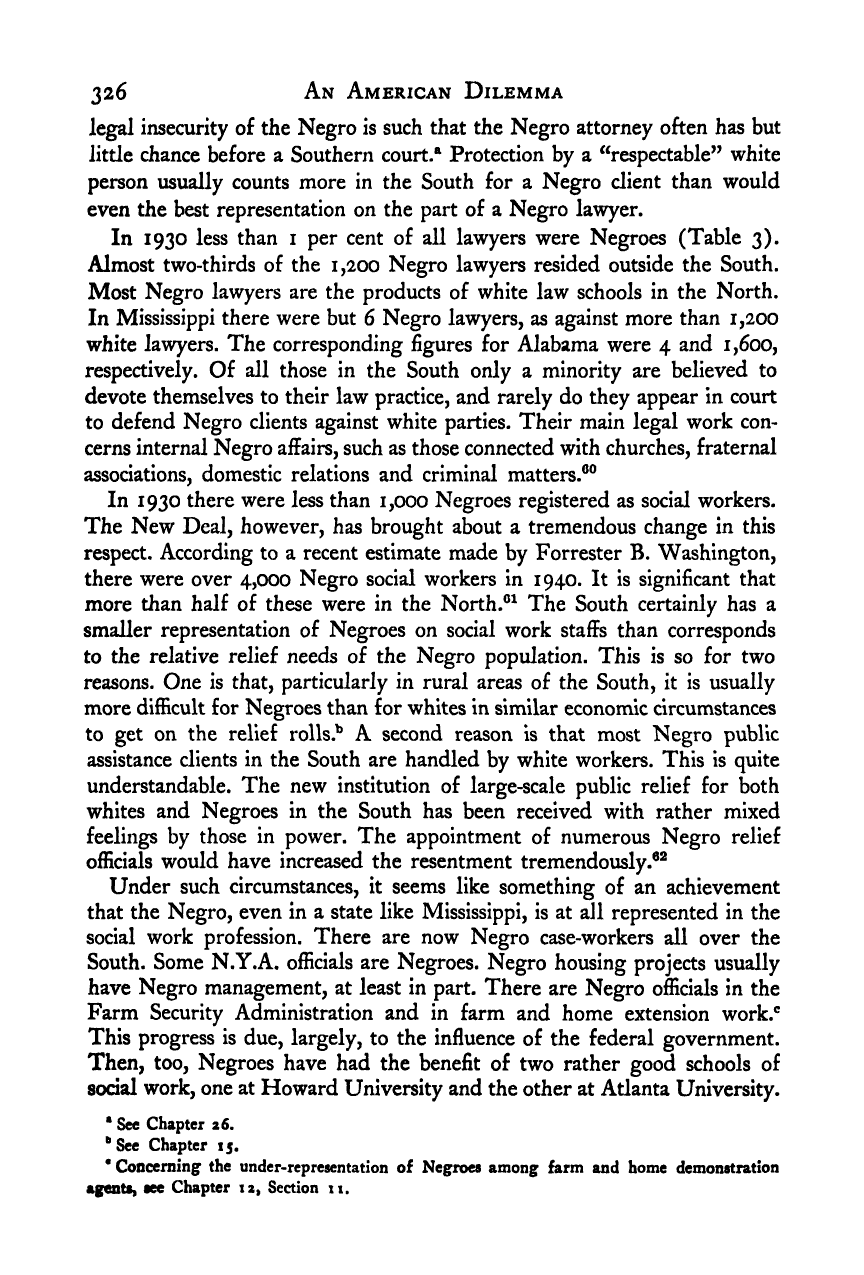Note: Gunnar Myrdal died in 1987, less than 70 years ago. Therefore, this work is protected by copyright, restricting your legal rights to reproduce it. However, you are welcome to view it on screen, as you do now. Read more about copyright.
Full resolution (TIFF) - On this page / på denna sida - IV. Economics - 14. The Negro in Business, the Professions, Public Service and Other White Collar Occupations - 7. Other Negro Professionals

<< prev. page << föreg. sida << >> nästa sida >> next page >>
Below is the raw OCR text
from the above scanned image.
Do you see an error? Proofread the page now!
Här nedan syns maskintolkade texten från faksimilbilden ovan.
Ser du något fel? Korrekturläs sidan nu!
This page has never been proofread. / Denna sida har aldrig korrekturlästs.
326 An American Dilemma
legal insecurity of the Negro is such that the Negro attorney often has but
little chance before a Southern court.® Protection by a ^^respectable” white
person usually counts more in the South for a Negro client than would
even the best representation on the part of a Negro lawyer.
In 1930 less than i per cent of all lawyers were Negroes (Table 3).
Almost two-thirds of the 1,200 Negro lawyers resided outside the South.
Most Negro lawyers are the products of white law schools in the North.
In Mississippi there were but 6 Negro lawyers, as against more than 1,200
white lawyers. The corresponding figures for Alabama were 4 and 1,600,
respectively. Of all those in the South only a minority are believed to
devote themselves to their law practice, and rarely do they appear in court
to defend Negro clients against white parties. Their main legal work con-
cerns internal Negro affairs, such as those connected with churches, fraternal
associations, domestic relations and criminal matters.®®
In 1930 there were less than 1,000 Negroes registered as social workers.
The New Deal, however, has brought about a tremendous change in this
respect. According to a recent estimate made by Forrester B. Washington,
there were over 4,000 Negro social workers in 1940. It is significant that
more than half of these were in the North.®^ The South certainly has a
smaller representation of Negroes on social work staffs than corresponds
to the relative relief needs of the Negro population. This is so for two
reasons. One is that, particularly in rural areas of the South, it is usually
more difficult for Negroes than for whites in similar economic circumstances
to get on the relief rolls.^ A second reason is that most Negro public
assistance clients in the South are handled by white workers. This is quite
understandable. The new institution of large-scale public relief for both
whites and Negroes in the South has been received with rather mixed
feelings by those in power. The appointment of numerous Negro relief
officials would have increased the resentment tremendously.®^
Under such circumstances, it seems like something of an achievement
that the Negro, even in a state like Mississippi, is at ail represented in the
social work profession. There are now Negro case-workers all over the
South. Some N.Y.A. officials are Negroes. Negro housing projects usually
have Negro management, at least in part. There are Negro officials in the
Farm Security Administration and in farm and home extension work.®
This progress is due, largely, to the influence of the federal government.
Then, too, Negroes have had the benefit of two rather good schools of
social work, one at Howard University and the other at Atlanta University.
• See Chapter 26.
*’See Chapter 15.
• Concerning the under-representation of Negroes among farm and home demonstration
agents, see Chapter 12, Section xi.
<< prev. page << föreg. sida << >> nästa sida >> next page >>